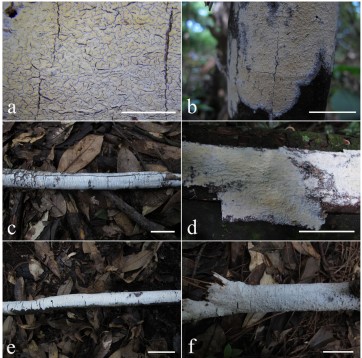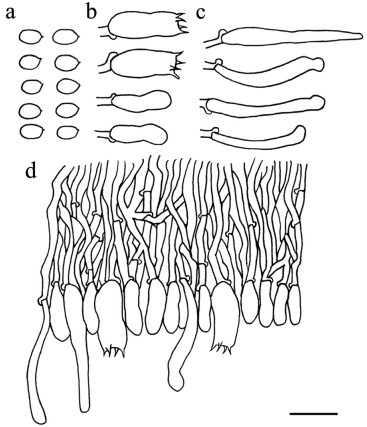Skvortzoviella lenis Jia Yu, Xue W. Wang, S.L. Liu & L.W. Zhou, sp. nov. (Figs. 12–13)
MycoBank number: MB 840232; Index Fungorum number: IF 840232; Facesoffungi number: FoF;
Etymology: lenis (Lat.), refers to the smooth hymenium.
Diagnosis: Similar to Skvortzovia georgica in the smooth hymenium, but S. georgica has slightly larger leptocystidia (30–32 × 4–5 μm) and allantoid basidio- spores (Gruhn and Hallenberg 2018).
Type: China: Yunnan: Baoshan: Gaoligong Mountains National Nature Reserve: Baihua Ridge, on angiosperm stump, 21 Sep. 2018, Li-Wei Zhou, LWZ 20180921-17 (HMAS – holotype).
Description: Basidiomes annual, closely adnate, widely effused, not easily separable, thin, membranous, rarely soft, usually with a few broad cracks or cracked extensively, 50–100 μm thick. Hymenophore smooth or irregular, white to cream when fresh, pale yellow to buff- yellow with age. Subiculum not stratified, white when fresh, light cream-coloured in dried material. Margin gradually thinning out, white, filamentose.
Hyphal system monomitic, generative hyphae with clamp connections. Subiculum composed of indistinct generative hyphae; subicular hyphae hyaline, thin- walled, frequently branched, 2–2.5 μm diam. Subhymenial hyphae hyaline, frequently branched, compact and agglutinated, 1.5–2.0 μm diam. Hymenial leptocystidia tubular with obtuse apices, hyaline, thin-walled, with a basal clamp connection, 15–30 × 1.5–3 μm. Basidia cylindrical, often with a median constriction, four sterigmata, 12–20 × 4.7–6 μm, tapering to 2.5–3.5 μm diam with a clamp connection at base; basidioles similar in shape to basidia, but smaller. Basidiospores ellipsoid, hyaline, smooth, thin-walled, acyanophilous, non-amyloid, non-dextrinoid, 4.8– 5.8(− 6.0) × (2.8–)2.9–3.5 μm, L = 5.1 μm, W = 3.1 μm, Q = 1.62–1.67 (n = 90/3).
Additional specimens examined: China: Yunnan: Baoshan: Gaoligong Mountains National Nature Reserve: Baihua Ridge, on fallen angiosperm twig, 21 Sep. 2018, Li-Wei Zhou, LWZ 20180921-7 (HMAS); loc. cit., on fallen angiosperm trunk, 21 Sep. 2018, Li-Wei Zhou, LWZ 20180921-25 (HMAS); loc. cit., on fallen angiosperm twig, 21 Sep. 2018, Li-Wei Zhou, LWZ 20180921- 32 (HMAS); loc. cit., on fallen angiosperm branch, 22 Sep. 2018, Li-Wei Zhou, LWZ 20180922-39 (HMAS), LWZ 20180922-61 (HMAS).
Notes: Skvortzovia furfuracea resembles Skvortzoviella lenis in the smooth to grandinioid hymenophore and ellipsoid basidiospores, but differs by the presence of halo- cystidia (Eriksson et al. 1981).

Fig. 12 Basidiomes of Skvortzoviella lenis. a, b LWZ 20180921-17 (holotype). c LWZ 20180921-32 (paratype). d LWZ 20180921-25 (paratype). e LWZ 20180922-39 (paratype). f LWZ 20180922-61 (paratype). Scale bars: a = 5 mm; b = 5 cm; c–f =3 cm

Fig. 13 Microscopic structures of Skvortzoviella lenis (drawn from holotype). a basidiospores. b basidia and basidioles. c leptocystidia. d a section of hymenial and subhymenial layer. Scale bar = 10 μm
